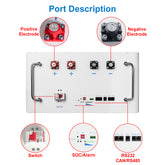Reasons to Use a BMS with LiFePO4 Cells and the Risks of Not Doing So
The growing popularity of lithium iron phosphate (LiFePO4) batteries in various applications, from electric vehicles to renewable energy storage, has highlighted the importance of using a Battery Management System (BMS). Many users underestimate the critical role of a BMS, assuming that LiFePO4 cells are inherently safe. However, a BMS plays a crucial role in maximizing the performance, lifespan, and safety of LiFePO4 batteries. In this article, we’ll explore why using a BMS with LiFePO4 cells is essential and the risks associated with not integrating this key component.
- What Is a BMS and Why Is It Essential for LiFePO4 Cells?
- The Risks of Not Using a BMS with LiFePO4 Cells
- How a BMS Enhances the Performance of LiFePO4 Cells
- Don’t Risk It – Always Use a BMS with LiFePO4 Cells
What Is a BMS and Why Is It Essential for LiFePO4 Cells?
A Battery Management System (BMS) is an essential electronic system that manages and protects lithium-ion batteries, ensuring they operate efficiently and safely. For LiFePO4 cells, which are commonly used in applications such as electric vehicles, solar energy storage, and portable power stations, the BMS regulates several vital functions.
Key Functions of a BMS
1.Voltage Regulation: LiFePO4 cells have a limited voltage range, typically between 2.0V and 3.65V per cell. A BMS ensures that each cell operates within this range to prevent overcharging or deep discharging, which could lead to cell damage or, in extreme cases, thermal runaway.
2.Current Monitoring: The BMS monitors the current flow to and from the battery, ensuring it doesn’t exceed safe limits. Overcurrent situations can cause heat buildup, which can damage the cells or cause a fire risk.
3.Temperature Management: LiFePO4 cells can perform optimally within a specific temperature range. A BMS monitors the temperature and takes action to cool or heat the system to maintain safety and efficiency.
4.State of Charge (SOC) Calculation: The BMS tracks the battery’s state of charge, providing accurate readings and warnings when the battery is close to full or depleted. This helps users avoid deep discharge, which can reduce the overall lifespan of the cells.
5.Balancing Cells: Over time, individual cells within a battery pack may charge or discharge at different rates. The BMS performs cell balancing, ensuring that all cells maintain an equal charge level, which is crucial for extending the battery's life.
>>See also How Long a 60V Lithium Ion Battery Typically Lasts in Golf Carts
The Risks of Not Using a BMS with LiFePO4 Cells
While LiFePO4 cells are more stable and safer compared to other lithium-ion chemistries, failing to use a BMS can expose users to several risks. Let’s explore the potential consequences of operating LiFePO4 cells without a proper BMS in place.
1. Risk of Overcharging and Deep Discharging
Without a BMS, there is no system in place to monitor and regulate the charging and discharging processes. Overcharging can lead to heat buildup, causing the cells to degrade prematurely. In extreme cases, overcharging can cause swelling or rupture. On the other hand, deep discharging can cause the cells to drop below the minimum voltage threshold, leading to irreversible damage.
2. Cell Imbalance and Reduced Lifespan
Over time, cells in a battery pack may become imbalanced. This means some cells could be overcharged, while others may be undercharged, causing uneven wear. A BMS ensures that each cell charges and discharges at an equal rate, prolonging the overall lifespan of the battery. Without a BMS, imbalance can result in decreased capacity, lower efficiency, and a reduced lifespan for the battery pack.
3. Thermal Runaway Risk
Although LiFePO4 cells are less prone to thermal runaway compared to other lithium-ion chemistries, temperature management remains a critical factor in ensuring safety. A BMS not only helps monitor temperature but can also control cooling systems or shut down the system if temperatures become dangerous. Without this regulation, the battery cells can overheat, causing damage or even a fire in extreme cases.
4. Potential for Overcurrent Situations
A BMS ensures that the current drawn from the battery never exceeds the safe threshold for the cells. Overcurrent can cause excessive heat buildup and even damage the internal components of the battery. In high-drain applications like electric vehicles, not using a BMS can lead to significant issues with battery performance and longevity.
How a BMS Enhances the Performance of LiFePO4 Cells
The primary benefit of a BMS is its ability to enhance the performance and longevity of LiFePO4 cells by offering real-time management and protection. Here are several key advantages a BMS provides:
1. Optimized Charging and Discharging
The BMS ensures that each LiFePO4 cell receives the correct charge and discharge cycles, helping maintain the cell’s health and optimizing energy storage. By avoiding the risks of overcharging or deep discharging, a BMS maximizes the efficiency of the entire system, providing a longer-lasting battery pack.
2. Enhanced Safety Features
As mentioned earlier, LiFePO4 cells are inherently safe, but integrating a BMS adds an extra layer of safety. With built-in protections against overcharging, overcurrent, temperature fluctuations, and other dangers, a BMS minimizes the risk of dangerous incidents and keeps the battery operating within safe parameters.
3. Real-Time Monitoring and Diagnostics
A BMS allows users to track vital battery parameters, such as voltage, temperature, and state of charge, in real time. This monitoring capability enables proactive maintenance, helping users address issues before they become serious problems.
4. Battery Balancing
One of the key features of a BMS is cell balancing. This ensures that the cells within a LiFePO4 battery pack remain at an equal state of charge, which is critical for both performance and longevity. Without a BMS, imbalance can occur, leading to inefficient energy storage and premature wear on certain cells.
>>See also Choosing Between 6V and 12V Batteries for Your Power Needs
Don’t Risk It – Always Use a BMS with LiFePO4 Cells
As we’ve discussed, using a BMS with LiFePO4 cells is crucial for maintaining safety, maximizing performance, and extending the life of the battery pack. The risks of not using a BMS include overcharging, deep discharging, thermal runaway, and imbalanced cells, all of which can damage the battery and even pose safety hazards. By integrating a BMS into your LiFePO4 system, you ensure that your battery operates within its optimal parameters, providing reliable and efficient performance for years to come.
In conclusion, a Battery Management System is not just a helpful addition to your LiFePO4 battery—it is a necessity. Protect your investment, enhance performance, and ensure safety by always using a BMS with LiFePO4 cells.



















Leave a comment
All blog comments are checked prior to publishing